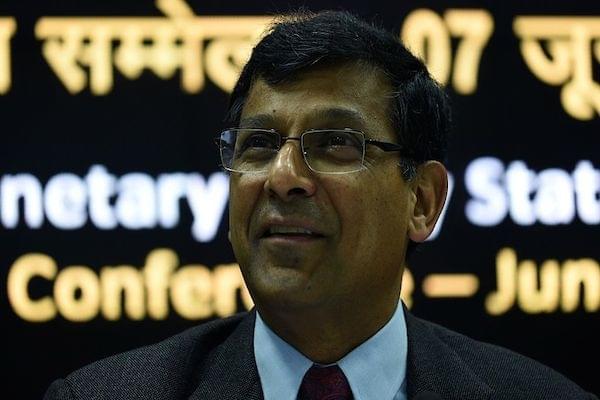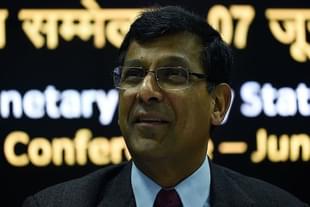Economy
Rajan’s Right: Tomtomming High GDP Is Less Useful Than A Focus On Reforms
R Jagannathan
Jul 18, 2016, 02:19 PM | Updated 02:19 PM IST
Save & read from anywhere!
Bookmark stories for easy access on any device or the Swarajya app.


Raghuram Rajan, who will be demitting office as Reserve Bank
Governor in less than two months, made two basic points in a recent interview. One,
he rejected the idea that he was behind the curve on his rate cuts; and two, he
said we should not be fixated with any particular GDP growth number.
He is bang on with both.
The truth is central banks will always be ahead of or behind the curve on inflation. This is because the data on which they base their interest rate policies come with a lag, and one can know only much later if rates were too high or too low. It is possible, with hindsight, to show that Rajan is behind the curve if retail inflation suddenly starts falling again after September this year. But right now it does not seem so, for the repo rate is at 6.5 percent and retail inflation at 5.77 percent, as Rajan noted in his Times of India interview today (18 July).
If at all Rajan has been behind the curve, it must have been in the July-September quarter of 2015 when the Consumer Prices Index (CPI) hit new lows in the range of 3.7 to 4.4 percent. It is those lows that will cause a spike now due to the base effect. But you can’t judge governors on the basis of what happened in three months. Since then, the CPI has been above five percent for all months barring March 2016.
Moreover, there is the problem of bad data. Rajan’s predecessor,
Duvvuri Subbarao, blamed bad data for some of his bad decisions. So one can’t even
be sure if Rajan has been behind the curve based on past CPI or WPI (Wholesale
Price Index) or GDP trends. Till recently, the WPI has been in deflation territory,
while CPI has always been positive. GDP has been buoyant, but many underlying
indicators (the Index of Industrial Production, exports, etc) indicate the need
for softer interest rates.
While the WPI has been abandoned as a guide for inflation targeting, there are now doubts about the new GDP series that uses the gross value added method for arriving at GDP estimates.
So Rajan is right to question the GDP obsession of politicians. The Modi government may want to claim an economic revival and use the latest GDP numbers (7.6 percent) to good effect, but the reality is that GDP growth does not matter even politically, unless other markers of “achche din” are also visible. These would be about jobs and real incomes.
Growth is the result of good policies and their effective implementation, policies which promote jobs and incomes. If this does not happen, having high GDP growth numbers is pointless.
What could these reforms be? The answer: political reforms may be as important as economic ones.
Real estate, construction and infrastructure can be the biggest job creators for every rupee of additional investment. This calls for reforms to free up these sectors— and the reforms required are both political and economic. Real estate cannot grow robustly as long as election funding has to be financed with slush funds and corruption. Politicians have a vested interest in high land prices, both rural and urban, since this is where their wealth resides. To boost jobs in real estate and construction, land prices have to be brought down, and this needs a boost in land supplies— which politicians are resisting as this will reduce their wealth. State funding of elections and transparency in land and building permissions are reforms which will free up land supplies and trigger a building and jobs boom. Electoral reforms are thus key to jobs revival in this sector.
Second, we need to free factor markets, which means both land and labour. While some states are moving ahead cautiously with land and labour reforms, to get a quantum leap, the centre must get out of the way. The UPA-era Land Acquisition Act is a problem. If the centre can repeal the law and let states make their own land laws, the resultant competition for investment and infrastructure and home building will ensure land reforms. The same goes for labour laws. The centre must let states lead reforms in factor markets in future. But this needs a big political deal between centre and states. Getting reforms through the Rajya Sabha— even to repeal a central act— needs support from regional parties. They may be willing to do this if states are given more powers through constitutional amendments. A political deal to give more powers to states provided regional parties help the centre repeal the Land Acquisition Act and ease labour laws is vital.
After the Uttarakhand and Arunachal fiascos, where the BJP’s attempts to install new governments failed miserably, the BJP can earn brownie points with the opposition if it promises changes in article 356 to make the toppling of state governments more difficult. It could even offer to abolish the post of Governor or make it a ceremonial one, where regional parties can get a say in who is appointed— an idea suggested by Nitish Kumar of Bihar.
The road to economic reforms runs through a more federated polity.
The NDA government has very little time before 2019. It needs to get cracking on political deals that will enable reforms in factor markets at the state level. Chasing some mythical GDP number is a waste of time.
Touting high GDP numbers also militate against lower rates: if the GDP is 7.6 percent and heading for eight percent this year with a good monsoon, it means high rates are not affecting growth. On the other hand, if the Government argues with the next RBI Governor that underlying growth is low, it may find a more attentive ear.
Jagannathan is former Editorial Director, Swarajya. He tweets at @TheJaggi.





